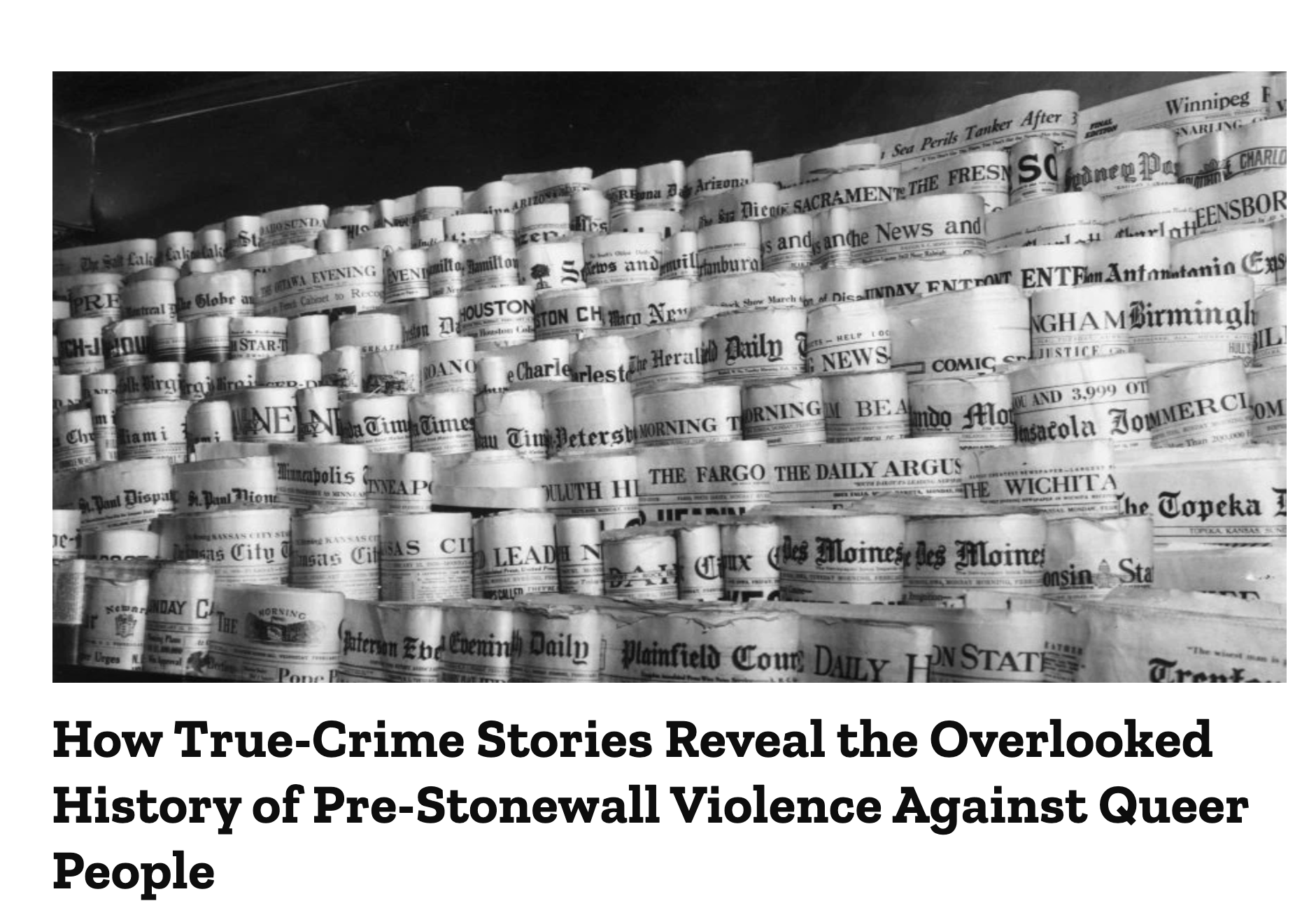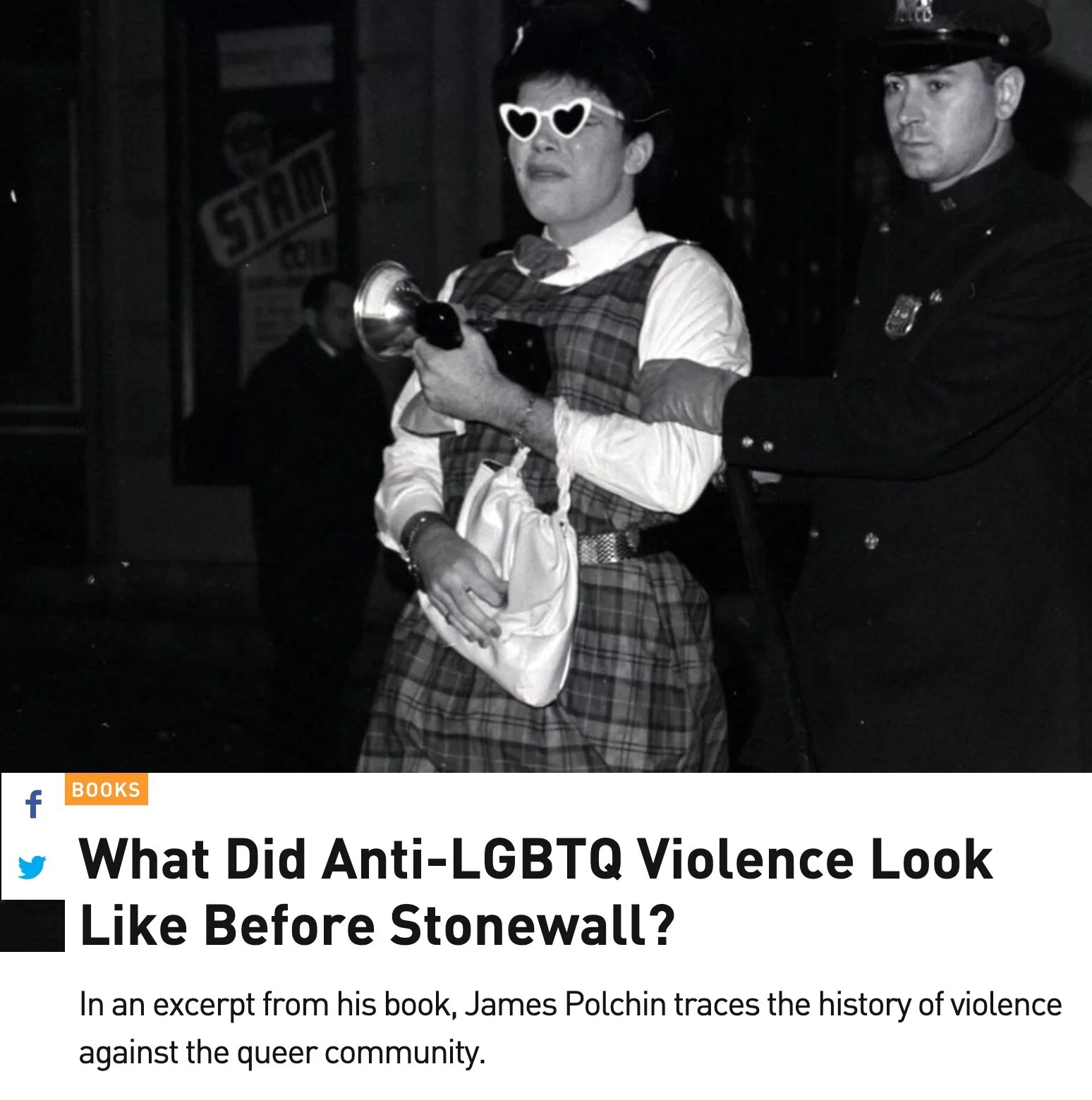The UK Edition--Out July 4th!
Cover reveal for the UK edition of “Indecent Advances” published by Icon Books this July. Quite a fancy pink, if I don’t say.
Cover reveal for the UK edition of “Indecent Advances” published by Icon Books this July. Quite a fancy pink, if I don’t say.

“Polchin takes a look at the crimes committed against gay men, long before equality and rights were a notion, let alone even being on the table.”
Read more at the Washington Blade and Windy City Times
“Polchin's book ends with the Stonewall riots and a new era of gay politics in which activists campaigned against flawed journalism and police work, but the "gay panic" defense, as it has come to be called, still exists, used as recently as 2018, in a case in Texas. While fewer gay men are killed in hate crimes today, approximately 28 trans women were murdered in 2018—and all but one were women of color. Under the current presidential administration, which promised its own "return to normalcy," there are still victims of rhetoric that is less of a dog whistle and more of a call to action against the "indecent." Polchin's book reminds us that this piece of history, like so many others, repeats itself.”
Read the whole review at the Chicago Reader.

“James Polchin joins us on the podcast to discuss how these stories shaped the public imagination about “deviant” behavior, and were fuel for homophobic discrimination from the sex panics of the 1930s to the Lavender Scare of the 1950s—and even today, when queer and trans people are still subjected to conversion therapy and newspapers underreport the murders of trans women of color.”
Listen to the interview with Stephanie Bastek at “Smarty Pants.”
“With the amount of LGBT literature that I read, it is quite hard to convince me of something new. Polchin was able to do so without twisting my arm at all. I was swept up into a world of crime in which the victims in no way deserved their fate. It was allotted simply based on their sexuality and nothing else. Since when is one’s sexuality a crime and how is punishment administered? This is the shocking information you will find here. … “
Read more at ReviewbyAmosLassen.com

“When I first started this research, few newspapers had digitalized their archives, making it nearly impossible to search for such crimes. Newspapers did not catalog “gay murders” in the decades before Stonewall. Even when the indexes began using the word “homosexual” in the late 1930s, it wouldn’t get me too far beyond sensationalized accounts or opinion pieces about “sex deviants.” But as more newspaper collections were digitalized, a new research strategy opened up. I could now focus on particular search terms such as “man found slain in hotel,” or “man found beaten in park” or “sailor found murdered.” These searches eventually produced pages and pages of articles that I would sift through searching for the clues to queer crime stories. From these leads, I searched the names of the victims or killers, which usually generated additional articles detailing the crime scene, the search for the assailants, arrests reports and, sometimes, reports on the court trials and sentence hearings….”
An article in TIME History about my research and writing process. Read more at TIME .

“I was walking in Greenwich Village, just on the edge of Chelsea in New York City, on a humid summer night when a car slowed down on the other side of the street and two men inside screamed out “faggot!” The impact of the word forced me to tense up. The street was empty. The hour was late. I could feel my heart start to pound and the adrenaline build. I thought if I turned around and cut back to where I came from, I could get away from whatever might happen next. In making a move, I watched from the corner of my eye as the car idled. The next second, it pulled off in the opposite direction, laughter trailing behind. That laughter stayed with me for months….”
Read more at NewNextNow
“In later chapters, Polchin rightly shifts his focus to hint at the seeds of progress in the struggle for gay equality. While they were never meant to be a salve for past atrocities or a panacea for future problems, milestones such as the 1948 Kinsey Report and ONE magazine’s 1953 pledge to “counter narratives of homosexual criminality and mental sickness in the popular press” both point to America’s nasty predilection for finger-pointing and remind us, as Polchin states in the book’s press materials, “that the legacy of criminalizing queer citizens is one we continue to live in, and one we (should) continue to fight against.”
Read more at the San Francisco Chronicle

In the fall of 1940, the badly beaten body of John Martin, a British citizen and steward on the Queen Elizabeth steamship, was found in the Hotel Belvedere in New York City. Martin was set to leave town the next day. Police would soon arrest two cowboys from Wyoming, who were in the city to perform a rodeo show at Madison Square Garden, for the crime. “Rodeo Performers Tell Police They Beat British Seaman for Improper Proposals,” the Brooklyn Eagle declared in its headline. The newspaper described how Martin’s body was found on the 14th-floor corridor of the hotel, where “a trail of blood led back to Room 1508.” Four cowboys had had a party in the room the night before, one of many such parties in the hotel, which was hosting the cowboy performers. The cowboys told police that during the party Martin had made an “improper proposal,” which sparked the attack, and police determined that Martin had been “dragged out to the corridor.” The article noted, “The room gave evidence of a violent battle.” Initially detectives confined all the rodeo performers to their rooms, placing police guards at the entrance of the hotel while they investigated the murder. This confinement was lifted to allow the cowboys to perform in that evening’s show.
The next day The New York Times described how two “cherubic cowboys” had confessed to the murder. The men had met Martin outside the hotel and invited him to their room where, after a “quarrel,” “the cowhands decided to ‘roll’ the Englishman.” The article described how one man held Martin while his “huskier companion punched the hapless steward until he slumped unconscious to the floor.”
Read more at Rolling Stone online

Anna North
What are some of the patterns you saw when you were reading these stories?
James Polchin
What fascinated me in the research was how these crime stories really did reflect the era’s anxieties. In the 1930s, the Depression, these stories of working-class men and wealthier companions were very prominent. The crime stories in that period also were about law and order, how the state was constantly on top of keeping law and order in a period that felt very unstable and very chaotic.
In the 1950s, and the postwar, Cold War period, you have the influences of [sexologist Alfred] Kinsey, and other newer theories of homosexuality that saw it more as an invisible threat. You see that in the crime stories. You see these ideas of homosexuals and communism: “You never know who might be a homosexual.” And the crime stories kind of play that out as well — we have a lot of stories of men who are married, men who are married with kids, seemingly normal men who had engaged in picking up men and taking them to a hotel room.
The crime stories really concentrated on a set of cultural values and beliefs around crime, or sexuality, or politics, in those decades before Stonewall.
Read more at VOX.